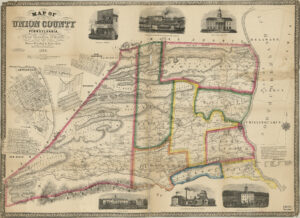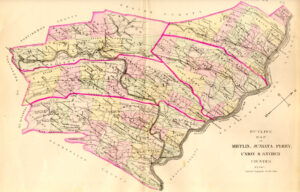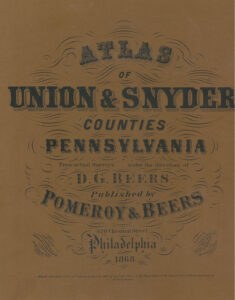Union County Landowner Resources
Ancestor Tracks is committed to becoming a one-stop resource for researchers of early Pennsylvania landowners. In addition to publishing our own books, we are posting images of 19th century maps and atlases that we personally took in the Library of Congress. Our goal is to post landowner maps, or links to other websites with landowner maps, for every county in the state.
Original Land Owners
The state of Pennsylvania began platting the exact metes-and-bounds tracts of the earliest landowners, township-by-township, starting in 1907, but the Land Office only completed about 1/3 of the state before the project ended. Unfortunately, the state of Pennsylvania did not plat the original warrantees and patentees on Union County township maps, other than for White Deer Township. However, there is a very large map hanging in the upstairs hallway of the Union County Courthouse that shows the first landowners. We took photos of the map (you can see the very indistinct images below the 1856 and 1868 map images) but a professional photographer needs to be engaged to do it justice.
The only way to find the date, book and page of the original warrant, survey, and patent for your ancestor is to do what the state draftsmen did to create their warrantee maps of other counties. They searched through the relevant county Warrant Register, and that of its parent counties, now posted on the Pennsylvania State Archives website where each page of each county’s ledger is a separate pdf file, or download and save to your computer the entire set of 67 county Warrant Registers plus 3 pre-1733 ledgers called First Landowners of PA: Colonial and State Warrant Registers in the PA Archives, Harrisburg, 1682-ca 1940 ($35). Once you have found the information, including the Survey Book and page number, you can access the free online surveys. You can also order copies of the original documents from the Pennsylvania State Archives in Harrisburg using their order form.
If you cannot find an original landowner’s name in the Warrant Registers, the next place to look is in Pennsylvania’s index to Patent Registers ($35). Within an index covering the relevant years, the names are grouped alphabetically by the first letter of the patentee’s surname, then grouped by volume number of Patent Book, and finally arranged chronologically by date of patent. Thus, you have to look through the entire alphabetical section (which may be as little as one page to as many as 50) to be sure you don’t miss anyone. See our explanation of how land was transferred from the government to individual owners from the earliest days of settlement.
The area that became Union county was settled by Pennsylvania Germans from Lancaster and Berks Counties in the 1740s while it was loosely connected with Lancaster County. Parts of Union and Snyder Counties were originally split between Berks County and Lancaster County (1750-1772) and then the two counties were absorbed into Northumberland County (1772-1813). Union County was created in 1813 and included Snyder County; finally, Snyder became its own county in 1855. These dates are important, as the earliest land warrants were filed under the county as it existed at the time the warrant was issued.
Please note that these land transfers predate the deed books located in each county because they deal with the first transfer of land to private individuals from Pennsylvania’s colonial or state government. Once the land passed into the hands of a private owner, any subsequent transfer of the land was recorded as deeds in the county courthouse as it existed at that time.
19th-Century Residents
As we have done for numerous Pennsylvania counties (hover over each county on the PA map), we are posting free, downloadable township images of from two sources that show residents: (1) The 1856 Map of Union County, Pennsylvania, Entirely from Original Surveys” by Thomas Pashall and James Keily; and (2) the 1868 Atlas of Union & Snyder Counties, Pennsylvania published by Pomeroy & Beers.
We hope that these landowner maps will be useful tools for locating your Union County families when coupled with the 1850-1880 census. They should also be an indispensable aid when used in conjunction with downloadable county histories: (1) Daniel Rupp’s 1847 History and Topography of Northumberland, Huntingdon, Mifflin, Centre, Union, Columbia, Juniata and Clinton Counties; (2) John Blair Linn’s Annals of Buffalo Valley, Pennsylvania which was published in 1877 and mentions many of the owners found in this 1868 atlas; and (3) Franklin Ellis’ 1886 History of that Part of the Susquehanna and Juniata Valleys Embraced in the Counties of Mifflin, Juniata, Perry, Union and Snyder in the Commonwealth of Pennsylvania (Volume I and Volume II).

Click on the township of your choice below. Once the images are loaded, they can be enlarged by clicking on them. If an image doesn’t enlarge, right-click on it and choose “Open Image in New Tab.” When it is opened in a new tab, you will be able to zoom in.
While the map in the Library of Congress, is in the public domain the images we have taken belong to us and are not to be used for commercial use. For those wishing to use them for personal use (including illustrating a family history you are working on), we give permission to use them, but we would appreciate attribution to Ancestor Tracks. It takes much time and effort to locate, process, edit, and post these and the many other county images we have posted, so we appreciate this courtesy.
Another version of this map is in the Leventhal Map Collection and has been posted by Boston Public Library
Click on this 1872 map to see Union County in perspective with its surrounding counties.
1856 Township Maps
Buffalo Township
East Buffalo Township
Gregg Township (created 1865 from White Deer)
Hartley Township
Jackson Township
Kelly Township
Lewis Township (part of Hartley until 1857)
Limestone Township
Union Township
West Buffalo Township
White Deer Township
Click on the township of your choice below. Once the images are loaded, they can be enlarged by clicking on them. If an image doesn’t enlarge, right-click on it and choose “Open Image in New Tab.” When it is opened in a new tab, you will be able to zoom in. You can also save the images.
While the map in the Library of Congress, is in the public domain the images we have taken belong to us and are not to be used for commercial use. For those wishing to use them for personal use (including illustrating a family history you are working on), we give permission to use them, but we would appreciate attribution to Ancestor Tracks. It takes much time and effort to locate, process, edit, and post these and the many other county images we have posted, so we appreciate this courtesy.
Boroughs, Towns and Villages
Map Showing Early Residents of Union County
Union County Court House
The next series of images is my attempt to publicize the large, framed warrantee map which is mounted on the wall in the Union County Court House. I took numerous photographs of the hanging map and tried to stitch them together, but the results are less than satisfactory. Nevertheless, I am posting these images with the hope that researchers will at least know that it is available and may be able to ask the Union Co. Historical Society (which is on the same floor in the courthouse) to take a picture of the desired portion of the map. I am posting seven “strips” of photos which overlap each other. They number from 1-7 showing the tracts from the top of the county to the bottom. Also, we are indebted to Eric Wagner of Mifflinburg who wrote the following clarification regarding the map. Many thanks, Eric!
“As for the large map, it is NOT a map of warrants or patents, but a connected draft of the RETURNED SURVEYS associated with those warrants and patents. Warrants are a type of land application that initiates title and afterwards these surveys are ordered and performed and returned by virtue of a plot or map of the land. And then a patent (which releases and clears title to the land) may be issued, but not always, as many warrants go unpatented–and MANY times patents are not granted to the warrantee/survey name associated with that tract of land. Therefore, these people may not have ever lived on, or even visited, these tracts of land with which their name is associated….”


